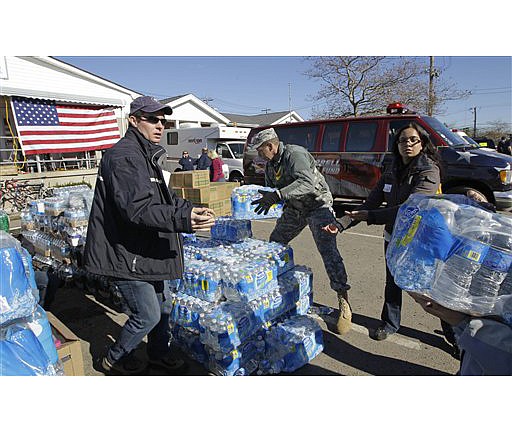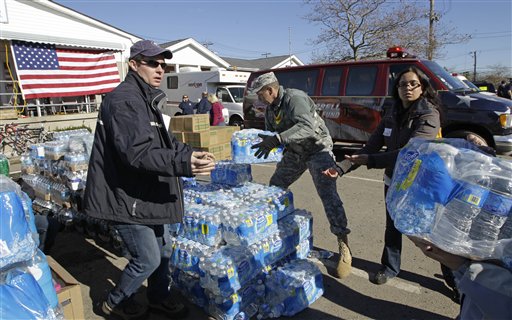Despite storm damage, election officials hopeful
Sunday, November 4, 2012
NEW YORK - Power generators are being marshaled, polling locations moved and voting machines hurriedly put into place as officials prepare to hold an national election in storm-ravaged sections of New York and New Jersey barely a week after Superstorm Sandy.
Organizers expressed guarded confidence Sunday that the presidential vote will proceed with no major disruptions in most areas hit by the storm, though it was unclear whether the preparations would be enough to avoid depressed turnout in communities where people still lack power or have been driven from their damaged homes.
Some voters will be casting ballots in places different from their usual polls.
In Long Beach, N.Y., a barrier-island city that was inundated with water during the storm, the number of polling places will be cut to four, down from the usual 11. Residents of the devastated borough of Sea Bright, on the New Jersey shore, will have to drive two towns over to vote.
But with two days to go until Election Day, officials in both states said Sunday that they were overcoming many of their biggest challenges.
Hundreds of emergency generators have been rushed into place to ensure power at polling places, even if the neighborhoods around them are still dark. Electric utilities were putting a priority on restoring power to others and had assured election officials they would be up and running by Monday.
Of the 1,256 polling locations in New York City, only 59 needed to be moved or closed, said Valerie Vazquez, a spokeswoman for the city's Board of Elections. Most were in coastal areas of Brooklyn and Queens or other neighborhoods where buildings normally used for voting had been turned into shelters.
Some New York City leaders remained worried. Mayor Michael Bloomberg noted that the polling-place changes would affect some 143,000 New Yorkers.
"Over the next day, it's going to be critical that the Board of Elections communicate this new information to their poll workers," he said.
The board, which is independent of the mayor's office, has historically had problems opening all voting locations on time, even in a normal year, the mayor noted.
Just east of the city, in Nassau County, Elections Commissioner William Biamonte warned that some voting locations would have a "paramilitary look," with portable toilets, emergency lighting and voting machines running off a generator.
As of Sunday morning, the county had 266,000 homes and business without power - more than anyplace else in the state. Some 30 to 40 polling locations, out of 375 in the county, were expected to be changed because of storm problems.
But Biamonte said he didn't expect that the problems would keep large numbers of people from casting ballots.
"I think people will be voting in less-than-optimal situations, but they will not be voting in a way that disenfranchises them," Biamonte said.
Yet for some residents of the hardest-hit areas, the hassle of having to travel even a few miles to find an open polling place was likely to be one burden too many.
William Agosto, who lost everything he owned when his basement apartment in the Far Rockaway area of Queens flooded, said he hoped to vote but couldn't guarantee he would have the energy or the time.
"I'm going to try," he said, clutching a garbage bag filled with donated clothing. "I have so much on my mind. What I'm going through, it's too much."
On Staten Island, where two polling locations were being relocated due to storm problems, bus driver Jim Holden said the election should be postponed.
"People can't get out to vote. Half these cars are under water," he said.
New Jersey residents driven from their homes by the storm were being given extra voting options. Registered voters will be able to apply for an absentee ballot by fax or email right through 5 p.m. on Election Day, and cast it via fax or email until 8 p.m. Displaced voters can also cast provisional ballots at any polling place in the state.
Monmouth County spokeswoman Laura Kirkpatrick said elections officials there had consolidated some polling locations and moved others, but expected to have working polls for all 53 municipalities come Election Day. She said the county was confident enough that it was encouraging people to vote in person, rather than scramble to file an absentee ballot by email.
"We are looking very good," she said.
Kirkpatrick said officials were somewhat concerned that residents might misunderstand the email voting option and try casting write-in ballots by sending messages to election officials, rather than go through the formal process of obtaining, signing and scanning an official ballot.
John Conklin, a spokesman for the New York Board of Elections, said some counties were training additional poll workers. The companies that make the state's electronic voting machines had sent scores of generators from other parts of the country to ensure enough power. And each polling location will be able to switch to paper ballots, if there is an unexpected loss of power on Election Day.
Utility companies in Connecticut promised that all polling places in that state would have power Tuesday.

